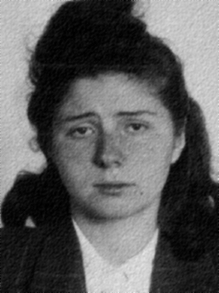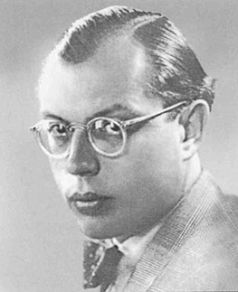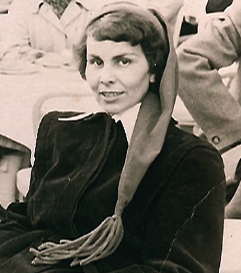
The Red Orchestra, as it was known in Germany, was the name given by the Abwehr Section III.F to anti-Nazi resistance workers in August 1941. It primarily referred to a loose network of resistance groups, connected through personal contacts, uniting hundreds of opponents of the Nazi regime. These included groups of friends who held discussions that were centred on Harro Schulze-Boysen, Adam Kuckhoff and Arvid Harnack in Berlin, alongside many others. They printed and distributed prohibited leaflets, posters, and stickers, hoping to incite civil disobedience. They aided Jews and resistance to escape the regime, documented the atrocities of the Nazis, and transmitted military intelligence to the Allies. Contrary to legend, the Red Orchestra was neither directed by Soviet communists nor under a single leadership. It was a network of groups and individuals, often operating independently. To date, about 400 members are known by name.

Liane Berkowitz was a German resistance fighter and was most notable for being a member of the Berlin-based pro-Soviet resistance group that coalesced around Harro Schulze-Boysen, that was later called the Red Orchestra by the Abwehr. Arrested and sentenced to death, she was executed shortly after she gave birth to a daughter in custody.

Wilhelm Guddorf was a Belgian journalist, anti-Nazi and resistance fighter against the Third Reich. Guddorf was a leading member of a Berlin anti-fascist resistance group that was later called the Red Orchestra by the Abwehr. Guddorf was the editor of the Marxist-Communist Die Rote Fahne newspaper.

Hans-Wedigo Robert Coppi was a German resistance fighter against the Nazis. He was a member of a Berlin-based anti-fascist resistance group that was later called the Red Orchestra by the Gestapo.

Arvid Harnack was a German jurist, Marxist economist, Communist, and German resistance fighter in Nazi Germany. Harnack came from an intellectual family and was originally a humanist. He was strongly influenced by Johann Wolfgang von Goethe but progressively moved to a Marxist-Socialist outlook after a visit to the Soviet Union and the Nazis' appearance. After starting an undercover discussion group based at the Berlin Abendgymnasium, he met Harro Schulze-Boysen, who ran a similar faction. Like numerous groups in other parts of the world, the undercover political factions led by Harnack and Schulze-Boysen later developed into an espionage network that supplied military and economic intelligence to the Soviet Union. The group was later called the Red Orchestra by the Abwehr. He and his American-born wife, Mildred Fish, were executed by the Nazi regime in 1942 and 1943, respectively.

Mildred Elizabeth Harnack was an American literary historian, translator, and member of the German resistance against the Nazi regime. After marrying Arvid Harnack, she moved to Germany in 1929, where she began her career as an academic. Mildred Harnack spent a year at the University of Jena and the University of Giessen working on her doctoral thesis. At Giessen, she witnessed the beginnings of Nazism. Mildred Harnack became an assistant lecturer in English and American literature at the University of Berlin in 1931.

Heinz Harro Max Wilhelm Georg Schulze-Boysen was a left-wing German publicist and Luftwaffe officer during World War II. As a young man, Schulze-Boysen grew up in prosperous family with two siblings, with an extended family who were aristocrats. After spending his early schooling at the Heinrich-von-Kleist Gymnasium and his summers in Sweden, he part completed a political science course at the University of Freiburg, before moving to Berlin on November 1929, to study law at the Humboldt University of Berlin. At Humboldt he became an anti-Nazi. After a visit to France in 1931, he moved to the political left. When he returned, he became a publicist on Der Gegner, a left-leaning political magazine. In May 1932, he took control of the magazine, but it was closed by the Gestapo in February 1933.

Libertas "Libs" Schulze-Boysen, born Libertas Viktoria Haas-Heye was a German Prussian noblewoman, who became a resistance fighter against the Nazis. From the early 1930s to 1940, Schulze-Boysen attempted to build a literary career, first as a press officer and later as a writer and journalist. Initially sympathetic to the Nazis, she changed her mind after meeting and marrying Luftwaffe officer Harro Schulze-Boysen. As an aristocrat, Schulze-Boysen had contact with many different people in different strata of German society. Starting in 1935, she utilized her position to recruit left-leaning Germans into discussion groups which she hosted at her and Harro's apartment, where they sought to influence her guests. Through these discussions, resistance to the Nazi regime grew, and by 1936, she and Harro began to actively resist the Nazis. During the early 1940s, whilst working as a censor for the German Documentary Film Institute, Schulze-Boysen began to document atrocities committed by the Nazis from photographs of war crimes forwarded by soldiers of the Sonderbehandlungen task force to the Film Institute.

Helmut Roloff was a German pianist, recording artist, teacher and resistance fighter against the Nazi regime. In September 1942 Roloff was arrested in Berlin in the roundup of an anti-Nazi resistance group allegedly at the centre of a wider European espionage network identified by the Abwehr under the cryptonym the Red Orchestra. Covered by comrades who persuaded their interrogators that his contact with the group had been unwitting, he was spared execution and released. In post-war West Berlin, Roloff taught at the Academy of Music. After serving as the school's director, he retired in 1978.

Marta Husemann was a German actress and anti-Nazi Resistance fighter in the Red Orchestra.

Horst Heilmann was a German resistance fighter against the Nazi regime. He was a member of the anti-fascist resistance group that formed around Harro Schulze-Boysen in 1940. Later, the people of the group along with many others were bundled together and called the Red Orchestra by the Abwehr. Heilmann was a student and a wireless operator who worked at the Referat 12 that was in the Inspectorate 7/VI.

Walter Küchenmeister was a German machine technician, journalist, editor, writer and resistance fighter against the Nazi regime. Küchenmeister was a member of the anti-fascist resistance group, that was later called the Red Orchestra by the Abwehr. Küchenmeister was notable for being part of the close group that constituted the Schulze-Boysen group of individuals.

Wolfgang Kreher Johannes "John" Graudenz was a German journalist, press photographer, industrial representative and resistance fighter against the Nazi regime. Graudenz was most notable for being an important member of the Berlin-based anti-fascist resistance group that would later be named by the Gestapo as the Red Orchestra and was responsible for the technical aspect of the production of leaflets and pamphlets that the group produced.
Gisela von Pöllnitz was a German journalist, communist, and resistance fighter against the Nazi regime. During the Nazi regime, she was a notable member of the Berlin-based anti-fascist resistance group around Harro Schulze-Boysen, later called the Red Orchestra by the Abwehr. Throughout her life von Pöllnitz had a lung condition that progressively worsened after being arrested several times by the Gestapo. On her final arrest by the Gestapo she contracted tuberculosis after 5 months in custody. Her physician Elfriede Paul arranged a sanitarium in Switzerland, but she never recovered.

Fritz Thiel was a German precision engineer and resistance fighter against the Nazi regime. He became part of a Berlin-based anti-fascist resistance group during World War II, that was later named the Red Orchestra by the Abwehr. Thiel along with his wife Hannelore were most notable for printing stickers using a child's toy rubber stamp kit, that they used to protest The Soviet Paradise exhibition in May 1942 in Berlin, that was held by the German regime to justify the war with the Soviet Union. The group found the exhibition both egregious and horrific; one exhibited photograph showed a young woman and her children hanged side by side. Thiel was executed for his resistance action.
Anna Krauss was a German clairvoyant, fortune-teller and businesswomen who became a resistance fighter against the Nazi regime, through her association with a Berlin-based anti-fascist resistance group that was later called the Red Orchestra by the Abwehr, during the Nazi regime.

Helmut Himpel was a German dentist and resistance fighter against Nazism. He was a member of the anti-fascist resistance group that was later called the Red Orchestra by the Abwehr. Himpel along with his fiancé Maria Terwiel were notable for distributing leaflets and pamphlets for the group. Specifically this included the July and August 1941 sermons of Clemens August Graf von Galen. The 2nd leaflet the couple posted, on Aktion T4 denouncing the murders of the sick by euthanasia, induced Hitler to stop the euthanasia murders and find other ways to do it.

Walter Husemann was a German communist and resistance fighter against the Nazi regime. As a young man, Husemann trained an industrial toolmaker, before training as a journalist. He became interested in politics and joined the Communist Party of Germany (KPD). With the arrival of the Nazis in 1933, he became a resistance fighter and through his wife, the actor Marta Husemann, he became associated with an anti-fascist resistance group around Harro Schulze-Boysen and Arvid Harnack that was later called the Red Orchestra by the Gestapo. Along with John Sieg whom he met in the KPD and Fritz Lange, Martin Weise and Herbert Grasse he wrote and published the resistance magazine, The Internal Front Die Innere Front.

Die Innere Front was a series of clandestine and illegal leaflets written and distributed by a group of communist resistance fighters from the Neukölln area of Berlin that were associated with the Red Orchestra during World War II. The leaflet was produced twice-weekly on a hectograph machine and translated in five languages, with each version having the byline "Campaign for a new free Germany". Communist Party of Germany (KPD) members that included the American journalist John Sieg along with the German printer Herbert Grasse, established the production of the leaflet from December 1941 onwards. It is considered the main organ of the Red Orchestra as many of them contributed to it.

Margarete "Joy" Weisenborn was a German resistance fighter against Nazism as well as a writer and later a singer.


















